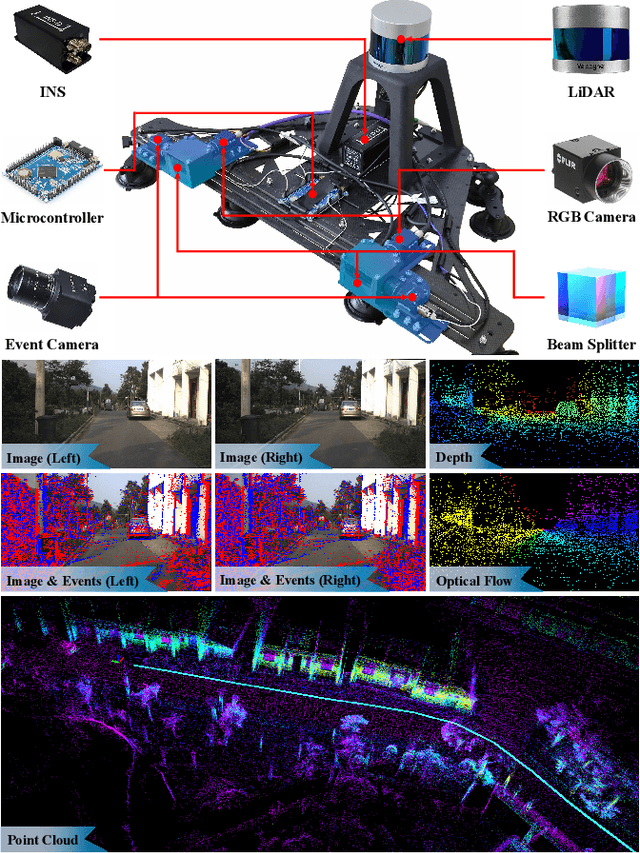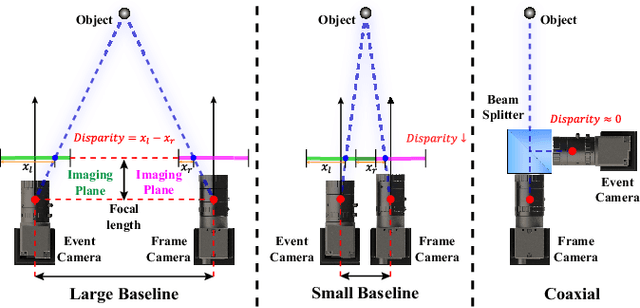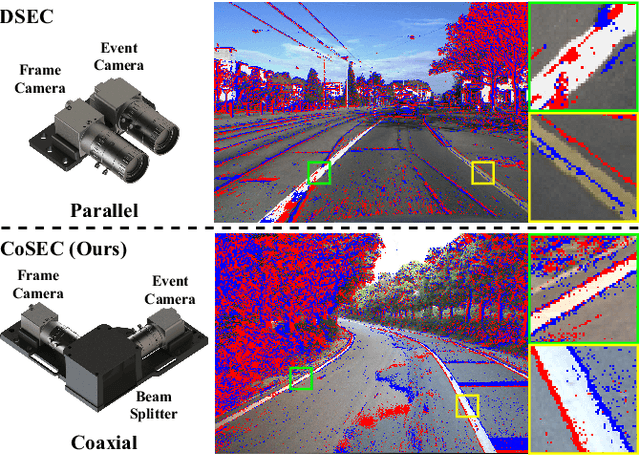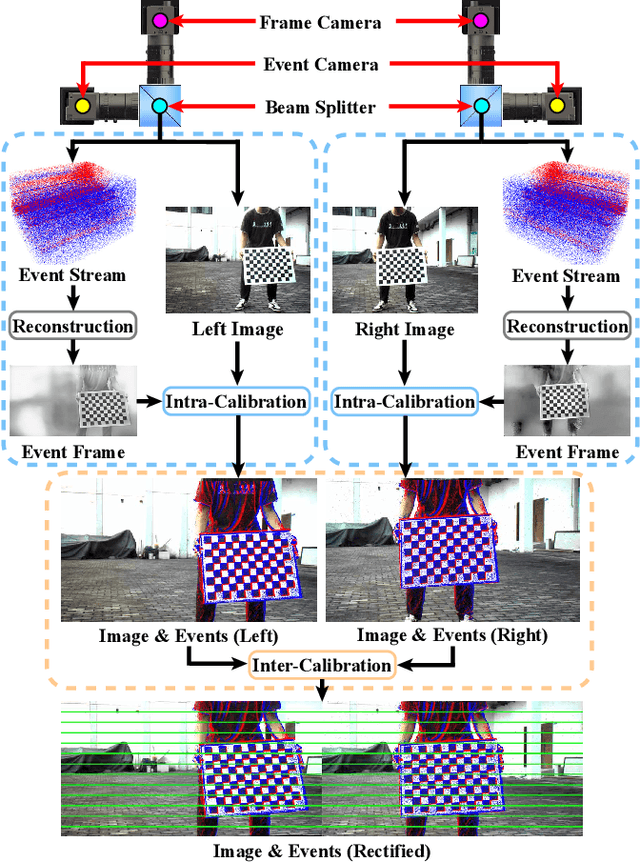Hanyu Zhou
LLaVA-4D: Embedding SpatioTemporal Prompt into LMMs for 4D Scene Understanding
May 18, 2025Abstract:Despite achieving significant progress in 2D image understanding, large multimodal models (LMMs) struggle in the physical world due to the lack of spatial representation. Typically, existing 3D LMMs mainly embed 3D positions as fixed spatial prompts within visual features to represent the scene. However, these methods are limited to understanding the static background and fail to capture temporally varying dynamic objects. In this paper, we propose LLaVA-4D, a general LMM framework with a novel spatiotemporal prompt for visual representation in 4D scene understanding. The spatiotemporal prompt is generated by encoding 3D position and 1D time into a dynamic-aware 4D coordinate embedding. Moreover, we demonstrate that spatial and temporal components disentangled from visual features are more effective in distinguishing the background from objects. This motivates embedding the 4D spatiotemporal prompt into these features to enhance the dynamic scene representation. By aligning visual spatiotemporal embeddings with language embeddings, LMMs gain the ability to understand both spatial and temporal characteristics of static background and dynamic objects in the physical world. Additionally, we construct a 4D vision-language dataset with spatiotemporal coordinate annotations for instruction fine-tuning LMMs. Extensive experiments have been conducted to demonstrate the effectiveness of our method across different tasks in 4D scene understanding.
TimeTracker: Event-based Continuous Point Tracking for Video Frame Interpolation with Non-linear Motion
May 06, 2025Abstract:Video frame interpolation (VFI) that leverages the bio-inspired event cameras as guidance has recently shown better performance and memory efficiency than the frame-based methods, thanks to the event cameras' advantages, such as high temporal resolution. A hurdle for event-based VFI is how to effectively deal with non-linear motion, caused by the dynamic changes in motion direction and speed within the scene. Existing methods either use events to estimate sparse optical flow or fuse events with image features to estimate dense optical flow. Unfortunately, motion errors often degrade the VFI quality as the continuous motion cues from events do not align with the dense spatial information of images in the temporal dimension. In this paper, we find that object motion is continuous in space, tracking local regions over continuous time enables more accurate identification of spatiotemporal feature correlations. In light of this, we propose a novel continuous point tracking-based VFI framework, named TimeTracker. Specifically, we first design a Scene-Aware Region Segmentation (SARS) module to divide the scene into similar patches. Then, a Continuous Trajectory guided Motion Estimation (CTME) module is proposed to track the continuous motion trajectory of each patch through events. Finally, intermediate frames at any given time are generated through global motion optimization and frame refinement. Moreover, we collect a real-world dataset that features fast non-linear motion. Extensive experiments show that our method outperforms prior arts in both motion estimation and frame interpolation quality.
Bridge Frame and Event: Common Spatiotemporal Fusion for High-Dynamic Scene Optical Flow
Mar 11, 2025Abstract:High-dynamic scene optical flow is a challenging task, which suffers spatial blur and temporal discontinuous motion due to large displacement in frame imaging, thus deteriorating the spatiotemporal feature of optical flow. Typically, existing methods mainly introduce event camera to directly fuse the spatiotemporal features between the two modalities. However, this direct fusion is ineffective, since there exists a large gap due to the heterogeneous data representation between frame and event modalities. To address this issue, we explore a common-latent space as an intermediate bridge to mitigate the modality gap. In this work, we propose a novel common spatiotemporal fusion between frame and event modalities for high-dynamic scene optical flow, including visual boundary localization and motion correlation fusion. Specifically, in visual boundary localization, we figure out that frame and event share the similar spatiotemporal gradients, whose similarity distribution is consistent with the extracted boundary distribution. This motivates us to design the common spatiotemporal gradient to constrain the reference boundary localization. In motion correlation fusion, we discover that the frame-based motion possesses spatially dense but temporally discontinuous correlation, while the event-based motion has spatially sparse but temporally continuous correlation. This inspires us to use the reference boundary to guide the complementary motion knowledge fusion between the two modalities. Moreover, common spatiotemporal fusion can not only relieve the cross-modal feature discrepancy, but also make the fusion process interpretable for dense and continuous optical flow. Extensive experiments have been performed to verify the superiority of the proposed method.
LLaFEA: Frame-Event Complementary Fusion for Fine-Grained Spatiotemporal Understanding in LMMs
Mar 10, 2025Abstract:Large multimodal models (LMMs) excel in scene understanding but struggle with fine-grained spatiotemporal reasoning due to weak alignment between linguistic and visual representations. Existing methods map textual positions and durations into the visual space encoded from frame-based videos, but suffer from temporal sparsity that limits language-vision temporal coordination. To address this issue, we introduce LLaFEA (Large Language and Frame-Event Assistant) to leverage event cameras for temporally dense perception and frame-event fusion. Our approach employs a cross-attention mechanism to integrate complementary spatial and temporal features, followed by self-attention matching for global spatio-temporal associations. We further embed textual position and duration tokens into the fused visual space to enhance fine-grained alignment. This unified framework ensures robust spatio-temporal coordinate alignment, enabling LMMs to interpret scenes at any position and any time. In addition, we construct a dataset of real-world frames-events with coordinate instructions and conduct extensive experiments to validate the effectiveness of the proposed method.
Cross-video Identity Correlating for Person Re-identification Pre-training
Sep 27, 2024



Abstract:Recent researches have proven that pre-training on large-scale person images extracted from internet videos is an effective way in learning better representations for person re-identification. However, these researches are mostly confined to pre-training at the instance-level or single-video tracklet-level. They ignore the identity-invariance in images of the same person across different videos, which is a key focus in person re-identification. To address this issue, we propose a Cross-video Identity-cOrrelating pre-traiNing (CION) framework. Defining a noise concept that comprehensively considers both intra-identity consistency and inter-identity discrimination, CION seeks the identity correlation from cross-video images by modeling it as a progressive multi-level denoising problem. Furthermore, an identity-guided self-distillation loss is proposed to implement better large-scale pre-training by mining the identity-invariance within person images. We conduct extensive experiments to verify the superiority of our CION in terms of efficiency and performance. CION achieves significantly leading performance with even fewer training samples. For example, compared with the previous state-of-the-art~\cite{ISR}, CION with the same ResNet50-IBN achieves higher mAP of 93.3\% and 74.3\% on Market1501 and MSMT17, while only utilizing 8\% training samples. Finally, with CION demonstrating superior model-agnostic ability, we contribute a model zoo named ReIDZoo to meet diverse research and application needs in this field. It contains a series of CION pre-trained models with spanning structures and parameters, totaling 32 models with 10 different structures, including GhostNet, ConvNext, RepViT, FastViT and so on. The code and models will be made publicly available at https://github.com/Zplusdragon/CION_ReIDZoo.
Adverse Weather Optical Flow: Cumulative Homogeneous-Heterogeneous Adaptation
Sep 25, 2024



Abstract:Optical flow has made great progress in clean scenes, while suffers degradation under adverse weather due to the violation of the brightness constancy and gradient continuity assumptions of optical flow. Typically, existing methods mainly adopt domain adaptation to transfer motion knowledge from clean to degraded domain through one-stage adaptation. However, this direct adaptation is ineffective, since there exists a large gap due to adverse weather and scene style between clean and real degraded domains. Moreover, even within the degraded domain itself, static weather (e.g., fog) and dynamic weather (e.g., rain) have different impacts on optical flow. To address above issues, we explore synthetic degraded domain as an intermediate bridge between clean and real degraded domains, and propose a cumulative homogeneous-heterogeneous adaptation framework for real adverse weather optical flow. Specifically, for clean-degraded transfer, our key insight is that static weather possesses the depth-association homogeneous feature which does not change the intrinsic motion of the scene, while dynamic weather additionally introduces the heterogeneous feature which results in a significant boundary discrepancy in warp errors between clean and degraded domains. For synthetic-real transfer, we figure out that cost volume correlation shares a similar statistical histogram between synthetic and real degraded domains, benefiting to holistically aligning the homogeneous correlation distribution for synthetic-real knowledge distillation. Under this unified framework, the proposed method can progressively and explicitly transfer knowledge from clean scenes to real adverse weather. In addition, we further collect a real adverse weather dataset with manually annotated optical flow labels and perform extensive experiments to verify the superiority of the proposed method.
CoSEC: A Coaxial Stereo Event Camera Dataset for Autonomous Driving
Aug 16, 2024



Abstract:Conventional frame camera is the mainstream sensor of the autonomous driving scene perception, while it is limited in adverse conditions, such as low light. Event camera with high dynamic range has been applied in assisting frame camera for the multimodal fusion, which relies heavily on the pixel-level spatial alignment between various modalities. Typically, existing multimodal datasets mainly place event and frame cameras in parallel and directly align them spatially via warping operation. However, this parallel strategy is less effective for multimodal fusion, since the large disparity exacerbates spatial misalignment due to the large event-frame baseline. We argue that baseline minimization can reduce alignment error between event and frame cameras. In this work, we introduce hybrid coaxial event-frame devices to build the multimodal system, and propose a coaxial stereo event camera (CoSEC) dataset for autonomous driving. As for the multimodal system, we first utilize the microcontroller to achieve time synchronization, and then spatially calibrate different sensors, where we perform intra- and inter-calibration of stereo coaxial devices. As for the multimodal dataset, we filter LiDAR point clouds to generate depth and optical flow labels using reference depth, which is further improved by fusing aligned event and frame data in nighttime conditions. With the help of the coaxial device, the proposed dataset can promote the all-day pixel-level multimodal fusion. Moreover, we also conduct experiments to demonstrate that the proposed dataset can improve the performance and generalization of the multimodal fusion.
Measuring Psychological Depth in Language Models
Jun 18, 2024Abstract:Evaluations of creative stories generated by large language models (LLMs) often focus on objective properties of the text, such as its style, coherence, and toxicity. While these metrics are indispensable, they do not speak to a story's subjective, psychological impact from a reader's perspective. We introduce the Psychological Depth Scale (PDS), a novel framework rooted in literary theory that measures an LLM's ability to produce authentic and narratively complex stories that provoke emotion, empathy, and engagement. We empirically validate our framework by showing that humans can consistently evaluate stories based on PDS (0.72 Krippendorff's alpha). We also explore techniques for automating the PDS to easily scale future analyses. GPT-4o, combined with a novel Mixture-of-Personas (MoP) prompting strategy, achieves an average Spearman correlation of $0.51$ with human judgment while Llama-3-70B scores as high as 0.68 for empathy. Finally, we compared the depth of stories authored by both humans and LLMs. Surprisingly, GPT-4 stories either surpassed or were statistically indistinguishable from highly-rated human-written stories sourced from Reddit. By shifting the focus from text to reader, the Psychological Depth Scale is a validated, automated, and systematic means of measuring the capacity of LLMs to connect with humans through the stories they tell.
Seeing Motion at Nighttime with an Event Camera
Apr 18, 2024



Abstract:We focus on a very challenging task: imaging at nighttime dynamic scenes. Most previous methods rely on the low-light enhancement of a conventional RGB camera. However, they would inevitably face a dilemma between the long exposure time of nighttime and the motion blur of dynamic scenes. Event cameras react to dynamic changes with higher temporal resolution (microsecond) and higher dynamic range (120dB), offering an alternative solution. In this work, we present a novel nighttime dynamic imaging method with an event camera. Specifically, we discover that the event at nighttime exhibits temporal trailing characteristics and spatial non-stationary distribution. Consequently, we propose a nighttime event reconstruction network (NER-Net) which mainly includes a learnable event timestamps calibration module (LETC) to align the temporal trailing events and a non-uniform illumination aware module (NIAM) to stabilize the spatiotemporal distribution of events. Moreover, we construct a paired real low-light event dataset (RLED) through a co-axial imaging system, including 64,200 spatially and temporally aligned image GTs and low-light events. Extensive experiments demonstrate that the proposed method outperforms state-of-the-art methods in terms of visual quality and generalization ability on real-world nighttime datasets. The project are available at: https://github.com/Liu-haoyue/NER-Net.
Bring Event into RGB and LiDAR: Hierarchical Visual-Motion Fusion for Scene Flow
Mar 12, 2024



Abstract:Single RGB or LiDAR is the mainstream sensor for the challenging scene flow, which relies heavily on visual features to match motion features. Compared with single modality, existing methods adopt a fusion strategy to directly fuse the cross-modal complementary knowledge in motion space. However, these direct fusion methods may suffer the modality gap due to the visual intrinsic heterogeneous nature between RGB and LiDAR, thus deteriorating motion features. We discover that event has the homogeneous nature with RGB and LiDAR in both visual and motion spaces. In this work, we bring the event as a bridge between RGB and LiDAR, and propose a novel hierarchical visual-motion fusion framework for scene flow, which explores a homogeneous space to fuse the cross-modal complementary knowledge for physical interpretation. In visual fusion, we discover that event has a complementarity (relative v.s. absolute) in luminance space with RGB for high dynamic imaging, and has a complementarity (local boundary v.s. global shape) in scene structure space with LiDAR for structure integrity. In motion fusion, we figure out that RGB, event and LiDAR are complementary (spatial-dense, temporal-dense v.s. spatiotemporal-sparse) to each other in correlation space, which motivates us to fuse their motion correlations for motion continuity. The proposed hierarchical fusion can explicitly fuse the multimodal knowledge to progressively improve scene flow from visual space to motion space. Extensive experiments have been performed to verify the superiority of the proposed method.
 Add to Chrome
Add to Chrome Add to Firefox
Add to Firefox Add to Edge
Add to Edge